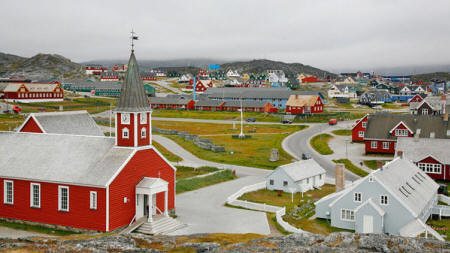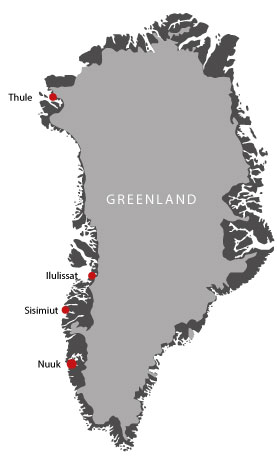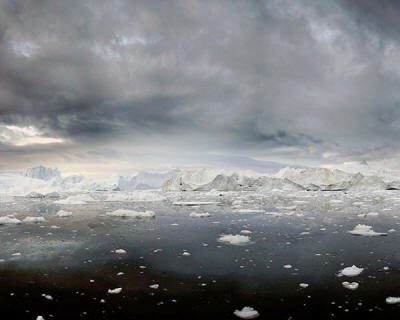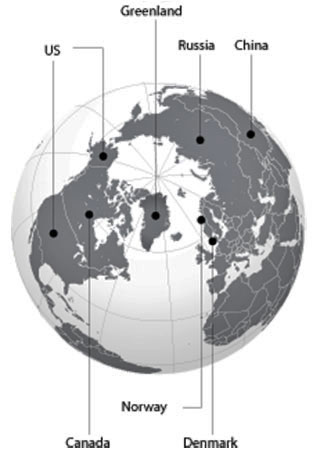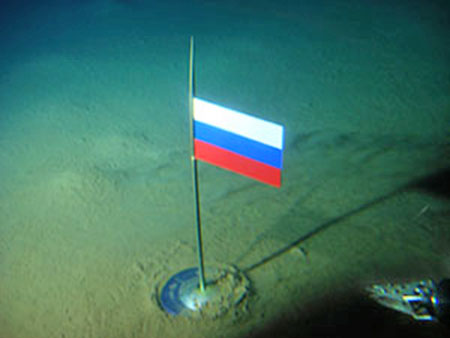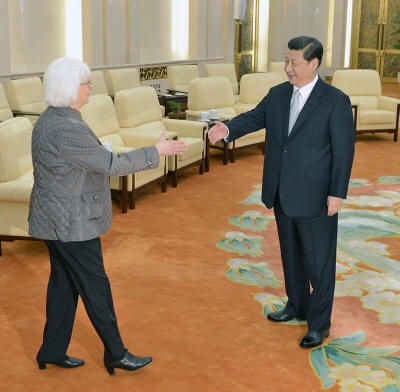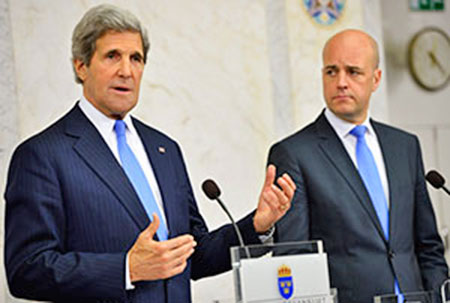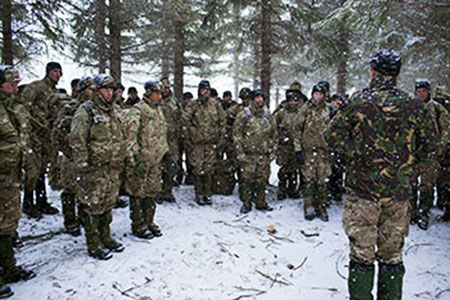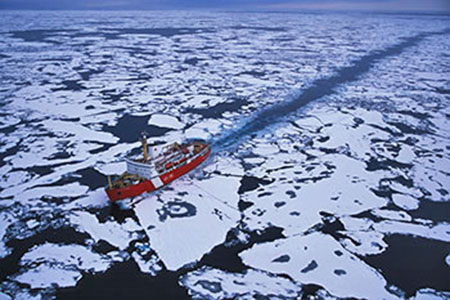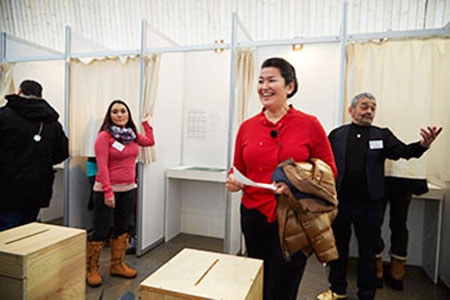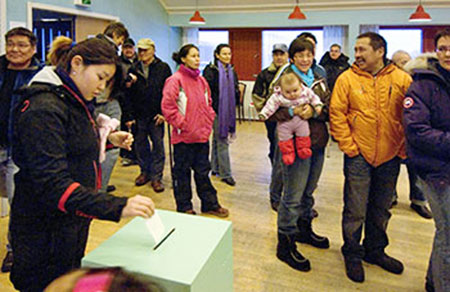|
December 6, 2013 from FT Website
have the Arctic’s natural resources and trade routes
in their sights
was founded by Lutheran
missionary Hans Egede 300 years ago
On a hill above the old harbor, Hans Egede braves biting winds to keep watch over the town he founded three centuries ago.
Bearing the commission of King Frederick IV of Denmark, the Lutheran pastor pitched up in Greenland in 1721. He planned to bring the Reformation to Norse settlers in this vast, frozen territory. As Egede navigated the ice fjords, he discovered his European kin had long since left in search of more clement climes.
Undeterred, he set about preaching the Protestant faith to the native Inuit, supplying Greenlandic with a Latin alphabet to promote study of the scriptures.
Egede’s mission established itself in Godthab (Good Hope) on the southwest coast of the island. Church was soon followed by trade and later by the state. Denmark - then a European power with imperial ambitions - acquired a colony.
Greenland is once again catching the imagination of outsiders. International business executives and diplomats are retracing Egede’s journey. The rapid melting of the northern polar ice has set off something of a scramble for the resources buried below.
By US estimates, the Arctic may hold 13 per cent of the world’s undiscovered oil and 30 per cent of its untapped gas as well as untold mineral resources. The London-based think-tank Chatham House talks of an Arctic "cold rush".
Greenland, a frozen and mostly empty sprawl of a country reaching up from the Atlantic to the Arctic Ocean, sees a chance to reclaim its pre-colonial identity.
Egede’s statue stares across the ice-speckled harbor to a cluster of timber-framed buildings housing the National Museum.
Greenland has wrested autonomy from Copenhagen, and visitors to the museum’s store of historic artifacts are left in little doubt about the colonial record. The hunting paraphernalia, furs, native art and wood-framed kayaks describing the harshness of polar life are accompanied by a commentary that excoriates the interlopers.
Christianity and colonization brought,
The "master race" corralled the indigenous people into new settlements to better supply Denmark with the spoils of sealing, whaling and fishing.
The Inuit were robbed of their spiritual compass as well as their physical freedom. The museum records this story in Greenlandic and in English - not in Danish, until recently the country’s official language.
Daniel Thorleifsen, the quietly spoken curator, brushes off my suggestion of bias in his museum’s celebration of the ancient crafts of the Inuit alongside its distinctly cooler assessment of the modernity imported from Denmark.
The narrative of repression represents "a simple statement of fact".
This was a sentiment I heard often in Greenland, sometimes from those of Danish as well as Inuit heritage. These lingering anti-colonial resentments have fired nationalist ambitions.
Now they are fusing with rising hopes that Greenland is in sight of an economic boom.
Greenlanders live in the more temperate coastal areas; the rest of its two million sq km are covered in ice
Isolated by Denmark, Greenland caught a brief glimpse of the outside world when Americans arrived during the second world war to deny Hitler’s Germany an Atlantic foothold.
During its nuclear stand-off with the Soviet Union, Washington stationed bombers at Thule in the far freezing north. But for the most part, Greenland has been a place the rest of the world passed by. Air travelers might glance at the dazzling, ice-sculpted terrain while crossing the Atlantic.
Bands of explorers and scientists ventured north to explore the high polar terrain or to drill deep into the ice core to trace the progress of climate change. Intrepid tourists marveled at the icebergs spilling from its glaciers into the open sea. But Greenland’s frozen nothingness made international headlines only when its hunters and whalers rebelled against the save-a-seal environmentalism of the European Union.
Things are changing. Two of the big forces shaping the world’s geopolitical contours are global warming and the voracious appetite for raw materials of the world’s big emerging markets. Both converge on Greenland’s retreating ice-sheet.
What happens next in the Arctic will touch the security and prosperity of the rest of the planet.
Climate change is remaking the Arctic, opening up new transpolar trade routes and offering tantalizing sight of the energy and mineral resources beneath the unforgiving tundra.
The impact is being felt in changing global weather patterns, migrating fish stocks and rising seas as far away as Asia and, crucially, in the calculations of the world’s great powers.
Huge blocks of ice from Greenland’s glaciers spill into the Atlantic currents through the Kangia Fjord. The discovery of iron ore, zinc, gold and much else has attracted prospectors from as far away as Australia. Deposits of rare earth materials could challenge China’s grip on the global trade in the valuable metallic elements vital to today’s technological gadgetry.
Greenlanders dream that the seabed beyond its northern coast might one day yield hydrocarbons to rival the riches on the slopes of Alaska.
Greenland isn’t green. Not much of it, anyway.
During the short summer a scattering of sheep peer down from the coastal hills to the ice floes below, but some 80 per cent of the two million square kilometers of territory (an area almost four times that of France) is sheeted with ice. The people - about 56,000 hardy souls at the latest count - mostly huddle together in small towns and settlements on the southwestern coastline.
As the writer Sara Wheeler notes in her magnificent chronicle of the modern polar region, The Magnetic North, the country was given its name by Erik Thorvaldsson, more popularly known as Eric the Red.
Arriving from Iceland during the 10th century, Erik had a 21st-century copywriter’s eye for marketing.
"Gronland", he thought, would conjure up images of fertile plains and draw in European settlers.
This part of the world has known big changes in climate before.
Warming temperatures during the eighth and ninth centuries brought Inuit tribes from Alaska and northern Canada - the Thule - who displaced the now-disappeared Dorset peoples in the frozen north. The Norse settlers arrived in the more temperate south. By the 15th century, however, the mercury was falling again.
The Norse disappeared, leaving behind the Inuit who, kept warm by the skins of their prey, could scratch a subsistence life by fishing or hunting whales, walruses, seals and musk oxen.
***
The latest change in the weather pattern is faster and more pronounced.
Arctic temperatures have been rising twice as fast as elsewhere. The polar region has lost about three-quarters of its sea ice. This summer the White House published a US strategy for the region.
The warming trend, it said,
This had the potential,
The prospects were for the opening of hitherto unnavigable sea passages from Asia to Europe and from the Pacific to the Atlantic.
The thaw could make accessible,
Governments and businesses are beating a path to the Arctic’s door, hoping to tap into potential riches revealed by climate change
So Greenland finds itself at the heart of one of the 21st century’s big geopolitical games: the race to stake out territory and interests in the world’s last ungoverned space.
One outcome may be a free-for-all in which competing states fight it out above and below the ice for control of trade routes and resources. Another, enshrined in the ambitions of the eight-nation Arctic Council, would see the creation of a unique structure of international co-operation charged with defusing tensions and safeguarding the unique ecology.
For now, there are pointers in both directions.
The council - comprising the five Arctic Ocean littoral states of the US, Russia, Canada, Norway and Denmark (representing Greenland), along with Sweden, Finland and Iceland - started out as a body preoccupied with the environment, marine safety and the rights of indigenous peoples.
More recently it has developed a broader political remit. The so-called Arctic Five have agreed that disputes about maritime boundaries will be settled peacefully under the terms of the United Nations convention on the law of the sea.
The Scandinavian members of the council see a chance to create an unprecedented model of "preventative diplomacy".
The Russian flag, seconds after being planted on August 2 2007
Whether such goodwill outlasts serious contact with conflicting claims to mineral resources and shipping rights is a tougher question.
In 2007, Moscow dispatched a submarine to plant the Russian national flag below the North Pole, thereby underscoring its claim to vast tracts of the Arctic seabed. Norway, usually nothing if not avowedly multilateral, has strengthened its military forces in the Arctic region and hosts regular exercises for NATO troops in the high north.
Normally placid Canada is boisterously nationalistic about its polar territory where it is embroiled in disputes with Washington about shipping rights in the Beaufort Sea.
The US, which after the second world war tried and failed to buy Greenland from Denmark (in 1917 it had completed a similar transaction with Copenhagen to secure ownership of what are now the US Virgin Islands), has only quite recently woken up to the broader strategic significance of the Arctic.
US secretaries of state, who had previously deputed their juniors to handle the region, now make a point of turning up at the regular ministerial gatherings of the Arctic Council.
The power plays reach beyond governments with an obvious territorial stake in the region.
China rebranded itself a "near-Arctic" state some time ago. After an intense diplomatic campaign - which Russia failed to scupper - Beijing has secured a seat as an observer on the Arctic.
It has signed free-trade and economic agreements with financially beleaguered Iceland in what western governments see as an attempt to establish an Arctic staging post.
With an eye on potential mineral resources, Beijing may send up to 3,000 workers to open an iron ore mine in Greenland.
All this stirs anxiety in Washington.
John Kerry and Swedish PM Fredrik Reinfeldt at the Arctic summit, May 2013
The pace of change in the Arctic will be slower than imagined by some excited commentators.
If chunks of Greenland’s glaciers now turn up as icebergs in the Caribbean, the polar region still has an awful lot of ice. China may have sent a cargo vessel to traverse the Arctic sea route above northern Russia - cutting weeks off the journey through the Suez Canal - but traffic is seasonal and negligible in comparison with traditional routes.
It will be decades before the polar seaways challenge the Suez and Panama canals.
Digging out minerals and pumping oil will be fraught with environmental and technical hazards. The terrain is inhospitable, communications difficult and mining operations expensive. The Inuit inhabitants of Alaska, Canada and Greenland are also determined to have their say.
Geopolitics does not wait for the future. Governments, businesses and NGOs are rushing to stake out ground. China has been joined as an observer on the Arctic Council by India, Singapore, South Korea, Japan and Italy - all states that consider they have an interest in access to new Arctic resources and trade routes.
An international organization that started out as a sleepy backwater for boffins and environmentalists has become an arena for strategic competition.
Greenland’s politicians may soon enough discover that climate change poses as many risks as it holds promises for a nation that wants to reclaim a vanishing identity.
***
Danish Godthab, the capital, was renamed Greenlandic Nuuk in 1979 when Greenlanders demanded autonomy from Copenhagen.
A home rule agreement in that year laid the foundations for a comprehensive self-government accord in 2009. This repatriated Denmark’s remaining powers over domestic policy, leaving foreign affairs and security to Copenhagen.
Greenland took full control of its economy, including the mineral and hydrocarbon resources, while remaining, like the Faroe Islands (another former colony lying between Denmark and Iceland) part of the "Danish realm".
Fights with European environmentalists about seal and whale hunting and fishing rights had already prompted Greenland to quit the European Union, though Denmark remains an EU member.
British Royal Marines train with NATO forces in Bardufoss, Norway, March 2013
Nuuk is at once a capital city and a village.
The jumble of pretty clapboard houses rising up from the rocks above the harbor gives way to a sprawl of flimsy, badly worn apartment blocks that might have been designed by an architect of the Soviet school. This is not an elegant town.
The 16,000 or so residents are served by a couple of small shopping centers, while a swelling band of business and diplomatic visitors converge on a single hotel.
The city’s bars are often full - long, dark winter nights, high unemployment and a culture of living-for-the-moment make for a disturbing tradition of heavy drinking. Sisimiut and Ilulissat, the next largest population centers, each have about 5,000 residents. Most Greenlanders live in towns of a thousand or two.
In the far north, a typical settlement is home to a hundred or less.
Canadian ice-breaker Louis S St-Laurent in the Beaufort Sea (part of the Arctic Ocean)
There are no roads connecting this scattering of communities.
The ice and the distances preclude even rudimentary highways. A single vessel of the state-owned shipping line plies its trade up and down the western coastline each week but people and products mostly get around by plane and helicopter. Everything rests on the weather-defying feats of Air Greenland.
Given the freezing weather, feats they are.
Christian Keldsen, the airline’s chief commercial officer, showed me around the hangars at Nuuk airport as a group of engineers stripped down one of half a dozen Dash turboprops. The flying warhorses are built for tough conditions but the mechanics wielded their wrenches with surgical care. Everything is checked, double checked and then checked again, every nut and bolt scrupulously accounted for.
The brutal conditions facing the pilots leave no room for mistakes.
An hour to the north, Kangerlussuaq serves as Air Greenland’s communications hub and the country’s lifeline to the outside world. Built by the Americans, the runway is one of only two long enough for long-range jets. For most of the year the airline runs a daily service to Copenhagen.
A ramshackle cluster of shops and homes assembled in wood and corrugated steel stands in dismal relief to the dazzling mountains that rise from the runway. In winter, temperatures here drop below -40°C.
A rickety hotel beside the single terminal is a reminder that even the sturdiest of aircraft must sometimes bow to the forces of nature.
The precariousness of this life - the mainstays of the economy are fishing and a small, though burgeoning tourism industry, and more than half of the government budget comes in the form of a subsidy from Copenhagen - has not dampened the enthusiasm of local politicians for independence.
Economy minister Qujaukitsoq says climate warming gives the country the chance to,
Lest anyone think there is a shortage of riches, he reels them off:
Kirkegaard, the mining minister, welcomes the world’s attention.
The government has lifted a decades-old ban on the mining of uranium which had applied even when the material was collected as an unavoidable byproduct.
The Australian-based Greenland Minerals and Energy describes the move as a "transformative event" which opens up huge potential for the mining of rare earths in southern Greenland. Kirkegaard says the timing for such developments is perfect - the demand for resources from the swelling middle classes of the emerging nations comes at the moment an investor spotlight has turned to the Arctic.
There are plenty of other places with untapped resources but,
It will take time to locate the oil and gas reserves but Shell, Maersk, Statoil and Cairn Energy are among companies with drilling licences.
For now, says Kirkegaard,
***
There is a Klondike quality about all this. Every summer a pilgrimage of prospectors arrives in search of gold, silver, diamond and ruby deposits. Some of them stay.
In Nuuk, Joshua Hughes, a Welsh-born geologist, took me to lunch. He had been visiting Greenland for years, he explained, before deciding to settle in the capital. He is a man with the gleam of riches in his eye.
As chief geologist for NunaMinerals, Hughes has been digging for gold; and he is sure he has discovered it. Nuna, he says, has found a valuable seam in southern Greenland, and is raising funds on the Toronto Stock Exchange to finance commercial exploitation.
Greenland’s future, though, may hang on one big deal. The British-based London Mining heads a consortium that wants to establish an iron ore mine at Isua, 100 miles north of Nuuk. Once in operation, this single project would have an output worth a staggering $2bn a year - equivalent to Greenland’s present national income.
To build the facility and a nearby deep-sea port, London Mining plans to bring in Chinese capital and up to 3,000 Chinese workers. Surveys and negotiations have dragged on over years but 2013 saw a breakthrough in talks with the government.
In what Kirkegaard terms a "historic moment", London Mining secured a 30-year license to exploit the ore.
More cautious voices say ministers are getting carried away by such heady optimism.
The government’s nationalist rhetoric, diplomats say, collides with some harsh realities. Greenland lacks the infrastructure, the people and the resources to rush into independence. If Denmark was once a rapacious colonial power, Greenland now depends on Copenhagen’s financial benevolence.
There are questions too about Aleqa Hammond, the feisty leader of the Simuit party, who won this year’s general election to become Greenland’s first woman prime minister. Hammond, local business leaders observe, looked a more convincing figure on the campaign trail than in government.
Some draw unflattering comparisons between Hammond and Kuupik Kleist, her predecessor and the leader of the Inuit Ataqatigiit party. Kleist earned a reputation as a "grown-up", a politician brave enough to take unpopular decisions to sort out the public finances and modernize an outdated fishing industry.
For all its commitment to independence the government struggles to shake off an air of amateurism - a sense that inexperienced ministers have not quite grasped the complexities and risks of the geopolitical game now being played in the Arctic.
Much of the work of administration still falls to officials born or trained in Denmark, while, perversely, Hammond’s vote-winning pledges have increased Greenland’s financial dependence on Copenhagen.
Greenlanders vote in a referendum on self-rule in November 2008
Kleist’s Inuit Ataqatigiit party spearheaded calls for independence during the 1970s and 1980s and he remains committed to the goal.
But he warns that the country lacks the financial and human capital to cut itself adrift any time soon. The problems lie not only in numbers - though finding the people to govern a state from a population of only 56,000 will never be easy - but in low educational attainment and high unemployment.
Nuuk boasts a small, bustling university but many children leave school with only minimal qualifications.
There is no point, Kleist says,
The cold rush throws up a profound paradox.
The world’s rediscovery of the Arctic, like Egede’s landing in Greenland, promises economic and social upheaval. Climate change threatens to elbow aside what remains of the precious traditions honored in Daniel Thorleifsen’s museum.
The number of native hunters in Greenland’s high north has fallen to less than a thousand. They are growing old and, as the ice melts, their children are moving south.
Climate change offers a platform for independence but it will not turn back history. It will more likely force Greenlanders to decide who they are. Centuries of intermingling and intermarriage have blurred the boundary between Greenlandic and Inuit.
Greenlanders of mixed or mostly Danish heritage say they too would like independence but they don’t look to the past for their future. There are those in Hammond’s government who say it is time to close the colonial chapter by retiring Egede from his towering vantage point.
The irony is they are not at all sure what they would put in his place.
|

